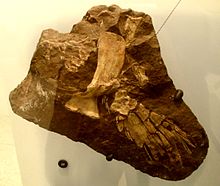Rhizodontida
| Rhizodontida Temporal range:
| |
|---|---|

| |
| A fossil of Sauripterus taylori
| |
| Scientific classification | |
| Domain: | Eukaryota |
| Kingdom: | Animalia |
| Phylum: | Chordata |
| Clade: | Sarcopterygii |
| Clade: | Tetrapodomorpha |
| Class: | †Rhizodontida |
| Order: | †Rhizodontiformes Andrews & Westoll, 1970 |
| Genera | |
| |
Rhizodontida is an extinct group of predatory
Description
The upper jaw had a marginal row of small teeth on the
The trunk was elongated, with
Rhizodont pelvic fins are known only from external morphology. They are smaller than the pectoral fins and positioned toward the rear of the body. In comparison to the other fins, the pectoral fins were much enlarged. They had a well-developed internal skeleton surrounded by robust, largely unsegmented
Phylogeny
The cladogram presented below is based on a 2021 study by Clement and colleagues:[4]
| Rhizodontida | |
Ecology
Judging from their anatomy, rhizodonts had an extremely powerful bite. They probably employed a 'grip and drag' hunting technique, where prey was ambushed, the tusks sunk in to secure it, and then depending on its size, either thrashed on the surface to subdue it, or dragged to where the rhizodont could consume it without being disturbed. Their prey probably included large sharks, lungfish, and other lobe-finned fishes, and even tetrapods, because all tetrapods at this time still had to lay their eggs in water.
References
- S2CID 227241079.
- ^ a b Coates, M. I.; Friedman, M. (2010). "Litoptychus bryanti and characteristics of stem tetrapod neurocrania". Morphology, Phylogeny and Paleobiogeography of Fossil Fishes: 389–416.
- ISBN 978-0-253-35675-8. Retrieved 19 May 2015.
- PMID 34966593.
- Johanson, Z. & Ahlberg, P.E. (1998) A complete primitive rhizodont from Australia. Nature 394: 569–573.
- Johanson, Z., and Ahlberg, P. E. (2001) Devonian rhizodontids and tristichopterids (Sarcopterygii; Tetrapodomorpha) from East Gondwana. Trans. R. Soc. Earth Sci. 92: 43–74.
Classification after
